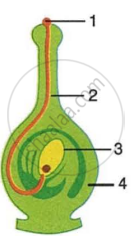Advertisements
Advertisements
प्रश्न
The chemical substance P is made and secreted by the meristematic tissue at the tip of stem (or shoot) of a plant. The chemical substance P is responsible for a phenomenon Q in plants in which the stem bends towards a source of light. The same chemical substance P has an opposite effect on the root of a plant. It causes the root of a plant to bend away from the source of light in a process called R.
(a) What is the chemical substance P?
(b) State whether P prefers to remains in the sunlit side of a stem or in shade.
(c) What is the effect of substance P on the rate of growth of (i) a root, and (ii) a stem?
(d) What is the name of process (i) Q, and (ii) R?
(e) What is the general name of chemical substances like P? Name another substance which belongs to this class of chemical substances.
उत्तर
(a) The chemical substance P is auxin.
(b) Auxin remains on the shaded side of the stem.
(c) Auxin increases the growth rate of shoots and decreases the growth rate of roots.
(d) Process Q is positive phototropism, whereas R is negative phototropism.
(e) The general name of chemical substances like auxin (P) is phytohormone. Cytokinins, gibberellins and abscisic acid are other examples of phytohormones.
APPEARS IN
संबंधित प्रश्न
Name the five types of tropisms.
To which directional stimuli do roots respond?
The plant part which exhibits negative geotropism is :
(a) root
(b) stem
(c) branch
(d) leaves
Which of the following acts as a stimulus in the process of hydrotropism?
(a) hydrocarbon
(b) hydrogen oxide
(c) hydrogen chloride
(d) hydrogen peroxide
How is movement in plants different from that in animals?
Any change in the environment to which an organism responds is called ____________.
The growth of tendrils in pea plants is due to
Heliotropism is a kind of ______.
Write the scientific terms used to represent the following:
Bending of roots towards the water.
The diagram given alongside shows a type of tropism. Study the same and answer the questions that follow:

- Name and define the type of tropism shown in the diagram.
- Label the guidelines (1) to (4).
- Name two effective stimulants that help in the growth of part (2).
- Name two groups of plants where part (2) grows towards gametophyte with the help of the stimulants mentioned in (c).
